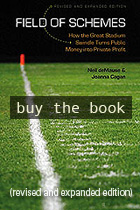This is an archived version of a Field of Schemes article. Comments on this page are closed. To find the current version of the article with updated comments, click here.
November 30, 2007
Rays stadium: The pretty pictures
The Satan-free Tampa Bay Rays rolled out the renderings this week, providing some glimpses of their proposed 35,000-seat, $450 million, sail-roofed waterfront stadium. It's hard to tell much about the design from the limited views made available - nothing of the interior seating bowl, for example - but they do seem to have figured out how to squish a modern stadium into a 10-acre site, albeit by moving a road and filling in part of the bayfront.
As for how it would be paid for, the St. Petersburg Times took a shot at unraveling the finances, concluding (as I did three weeks ago) that while the project wouldn't directly use public tax money, it would use public assets:
City and county property taxes from the Tropicana site would be redirected under a city program already in place into downtown capital projects - in this case, the new stadium.
The money, of course, is not the team's to spend. But without the Rays moving to the waterfront, there would be no money for the city or county or any other taxing authority to spend, either.
In that regard it's not a new tax, but rather the sale of a city asset, [city councilmember Bill] Foster and others said Thursday.
In other words, the city would be paying off the Rays for vacating the Tropicana Dome site and opening it for development by giving the team a cut of the proceeds. How much of a cut? The Rays owners say as much as $300 million - which, given that the entire site is possibly worth only $200 million, could come to more than the entire pie. That seems an awfully high price to pay for banishing indoor baseball, even given recent precedent in that area.
If all goes according to the team's plans, the public will get to weigh in on the project next November in a citywide referendum. Given that, according to a St. Pete Times poll, 57% of city voters favored a new stadium if taxpayers weren't paying for it, and 69% opposed it if they were, a lot could hinge on the semantics of whose money this really is.
"The money, of course, is not the team's to spend. But without the Rays moving to the waterfront, there would be no money for the city or county or any other taxing authority to spend, either."
There's your talking points.
Good little lapdog, goood doggie!
In short, the Rays want to break their existing stadium lease and have the city pay for that.
The value of the exiting Tropicana field site for development purposes can be viewed like money in a certificate of deposit in the bank. If the city wants to get the money now, the "early deposit withdrawal penalty" will be 100%, i.e. all of the money will need to go to the Rays to subsidize the breaking of the lease and making the property available. On the other hand, if the city holds the Rays to their lease, the value of the site remains in the hands of the taxpayers and can be spent later on anything, not just subsidies for baseball. Since current economic condidtions have likely reduced the value of the site, it will likely be worth much more later.
The negatives of this deal for St. Petersburg city taxpayers are so significant that the whole city will end up "stadium poor" for a generation if this deal goes through. But, given recent history, the Rays are unlikely to be satisfied with the new stadium for more than 10 years. At that time, however, the city is scheduled to still be paying off bonds issued to build Tropicana Field.
In short, the Rays want to break their existing stadium lease and have the city pay for that.
The value of the exiting Tropicana field site for development purposes can be viewed like money in a certificate of deposit in the bank. If the city wants to get the money now, the "early deposit withdrawal penalty" will be 100%, i.e. all of the money will need to go to the Rays to subsidize the breaking of the lease and making the property available. On the other hand, if the city holds the Rays to their lease, the value of the site remains in the hands of the taxpayers and can be spent later on anything, not just subsidies for baseball. Since current economic condidtions have likely reduced the value of the site, it will likely be worth much more later.
The negatives of this deal for St. Petersburg city taxpayers are so significant that the whole city will end up "stadium poor" for a generation if this deal goes through. But, given recent history, the Rays are unlikely to be satisfied with the new stadium for more than 10 years. At that time, however, the city is scheduled to still be paying off bonds issued to build Tropicana Field.





